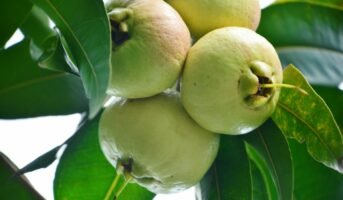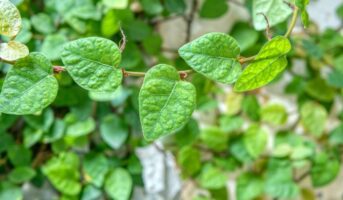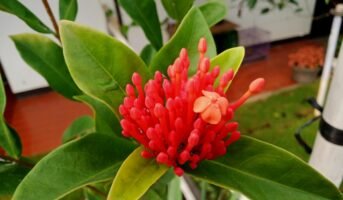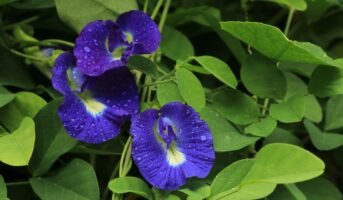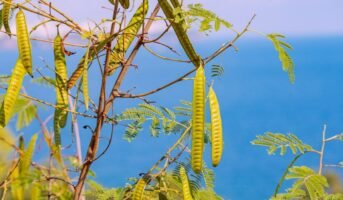Pigweed is the common term for a number of closely related summer annuals that have spread like wildfire throughout most of the world and the United States, decimating vegetable and row crops.
The majority of pigweeds are tall, erect bushy plants with simple, alternating leaves in the shape of an oval to diamond and dense inflorescences (flower clusters) made up of numerous small, greenish flowers. Within the frost-free growing season, they emerge, develop, bloom, produce seeds, and then perish.
Trianthema portulacastrum: Quick facts
| Found in | Tropical and subtropical countries |
| Leaf shape | Flat and elliptic |
| Flowers | Pink and red |
| Length | Upto 1 ft |
| Flowers | White, pink to pinkish-purple, |
| Common Name | Pigweed |
| Family | Aizoaceae |
| Native | United States |
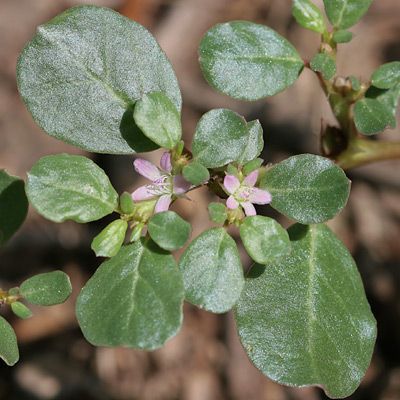
Source: Pinterest
Trianthema portulacastrum: Description
- Leaves: Green or reddish-green, shiny, tiny, succulent leaves that are rounded to oval in shape and measure between 1.2 and 3.5 centimetres in length and 0.8 and 2.2 centimetres in width. The leaves are held opposite one another, with the smaller leaf protruding further than the larger one.
- Flowers: White, pink to pinkish-purple, solitary flowers that bloom only in the morning are quite little (approximately 7 mm across).
- Fruits: Capsules, which are dry fruits that open when they reach maturity. They are cylindrical, curved, and have two erect, pointy “wings” or awns on top. When the capsule opens, six to eight seeds are released.
- Seeds: Reddish-brown to black, kidney-shaped seeds (1.3 mm wide).
Trianthema portulacastrum: Temperature and climate
Pigweeds respond well to high quantities of available nutrients, flourish in hot climates, and have evolved to escape being shaded by extending their stems quickly. They actively contend with warm-season crops and proliferate through copious seed production.
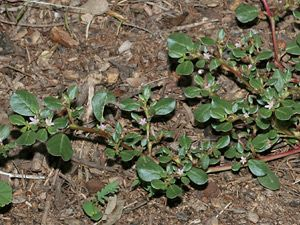
Source: Pinterest
What are the benefits of Trianthema portulacastrum?
The plant is harvested from the wild for local uses. Although it is widely known to be a weed, it also has medicinal properties. Sometimes the plant is eaten. Moreover, the dried plants are traded for their medicinal benefits. Traditionally, the plant is used as analgesic and laxative, and for treatment of various diseases. In Africa, the young tops and leaves are consumed as a cooked vegetable or in soups. However, it may be toxic.
Tips for dealing with Trianthema portulacastrum
There is no clear method for controlling this weed Trianthema portulacastrum. Some of the common ways used for controlling this weed include hand weeding and hoeing. However, manual weeding can be an expensive and time consuming process. Besides, it can be ineffective to control this weed. Trianthema portulacastrum must not be allowed to attain maturity. It should be controlled at the seedling stage in heavily infested fields. When the plants are in the fruiting stage, they must not be cut and left in the field, because this may allow the fruit to mature and the seed to be dispersed.
Should you grow pigweed?
Since pigweed is a type of weed, you would not want to grow them at your house.
Are pigweed plants edible?
Yes, the Trianthema portulacastrum known as pigweed in the garden, particularly prostrate pigweed, is non-toxic and edible. Although the entire plant can be consumed, the tenderest and most delicious parts are the young leaves and growing tips on older plants. The seeds are easy to harvest, delicious, and healthy.
How can you consume pigweed?
It can be used primarily in the same manner as any other edible green. Stick to the young leaves and new shoots for raw consumption. These can be used similarly to spinach or salad greens. Like chard or turnip greens, the young and older leaves can also be sautéed or steamed. Iron, calcium, and vitamins A and C are all present in the leaves.
Trianthema portulacastrum: Impacts
In many crop production systems, Trianthema portulacastrum is an extremely problematic weed. The yields of crops like cotton, mustard, maize, pearl millet, sugarcane, pigeon pea, mung bean, soybean, potato, and onions are all negatively impacted by this significant noxious weed in India.
Infestations in cotton, maize, and rice can lower crop yields by 32% to 60% during the wet season. If left untreated, horse purslane can diminish the production of mung beans in India by 50–60%. The red hairy caterpillar (Amsacta moorei), the beet leafhopper (Circulifer tenellus), Rhizoctonia solani, and the chilli mosaic virus all use it as a host plant. Although the plant is used as fodder, animals may become ill from it.
FAQs
What is Trianthema portulacastrum's common name?
A type of flowering plant in the ice plant family called Trianthema portulacastrum is also referred to as desert horsepurslane, black pigweed, and huge pigweed. It is found as an imported species in many other places, but it is native to parts of several continents, including Africa and North and South America.
How is Trianthema portulacastrum preserved?
One method of preserving purslane is pickling. After picking Trianthema portulacastrum, place it in a plastic bag and immediately place it in the refrigerator or a cooler bag. It can remain fresh for up to a week in the fridge. Wait until right before you are ready to eat before washing it.
Housing News Desk is the news desk of leading online real estate portal, Housing.com. Housing News Desk focuses on a variety of topics such as real estate laws, taxes, current news, property trends, home loans, rentals, décor, green homes, home improvement, etc. The main objective of the news desk, is to cover the real estate sector from the perspective of providing information that is useful to the end-user.
Facebook: https://www.facebook.com/housing.com/
Twitter: https://twitter.com/Housing
Email: [email protected]

